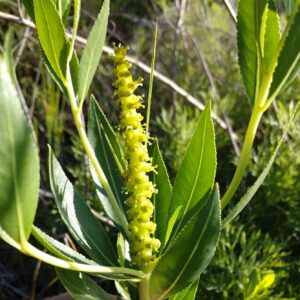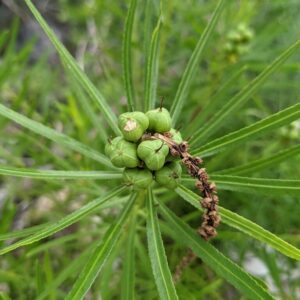Both of these unique, regal perennials are joyful — and hardy — additions to our dry, sandy areas.
So far with our tales of two plants, I’ve introduced a more common plant that grows in clay soil and its rarer sandy soil relative. But this time it’s the sandy-land plant that’s more widespread, and the Hill Country one has a restricted range.
It’s time to talk about two queen’s delights: Stillingia sylvatica and Stillingia texana.
 Stillingia sylvatica, aka queen’s-delight, is a leafy perennial that grows in sandy fields and forests in the southern United States from Virginia in the East to New Mexico in the West. It’s a multi-stemmed herbaceous plant growing to about 4 feet but is usually shorter. The oval leaves are thick and glossy green, and while the yellow-green flowers aren’t particularly showy, they do form a dense spike at the ends of each stem. A member of the spurge family, queen’s-delight seeds are a good food source for game birds like doves and quail and small mammals. The plant forms a large tap root; some I’ve seen were as thick as my wrist.
Stillingia sylvatica, aka queen’s-delight, is a leafy perennial that grows in sandy fields and forests in the southern United States from Virginia in the East to New Mexico in the West. It’s a multi-stemmed herbaceous plant growing to about 4 feet but is usually shorter. The oval leaves are thick and glossy green, and while the yellow-green flowers aren’t particularly showy, they do form a dense spike at the ends of each stem. A member of the spurge family, queen’s-delight seeds are a good food source for game birds like doves and quail and small mammals. The plant forms a large tap root; some I’ve seen were as thick as my wrist.
 Stillingia texana, or Texas queen’s delight, only grows in the rocky soils that stretch from Northern Mexico through Central Texas, and into southern Oklahoma. Texas queen’s delight is much smaller, generally less than two feet in height, and the leaves much thinner. The flowers are similar, and the fruits are likewise important for wildlife. Texas queen’s delight is hardy and often seen growing out of little more than limestone cracks.
Stillingia texana, or Texas queen’s delight, only grows in the rocky soils that stretch from Northern Mexico through Central Texas, and into southern Oklahoma. Texas queen’s delight is much smaller, generally less than two feet in height, and the leaves much thinner. The flowers are similar, and the fruits are likewise important for wildlife. Texas queen’s delight is hardy and often seen growing out of little more than limestone cracks.
The conditions in Central and South Texas, along with the climate, can often be hard on plants. The differing soil types require different adaptations for survival creating conditions for speciation.
We’re lucky to live on the edges of these ecoregions that have molded common species found across the U.S. into new species that are not found anywhere else on earth.


